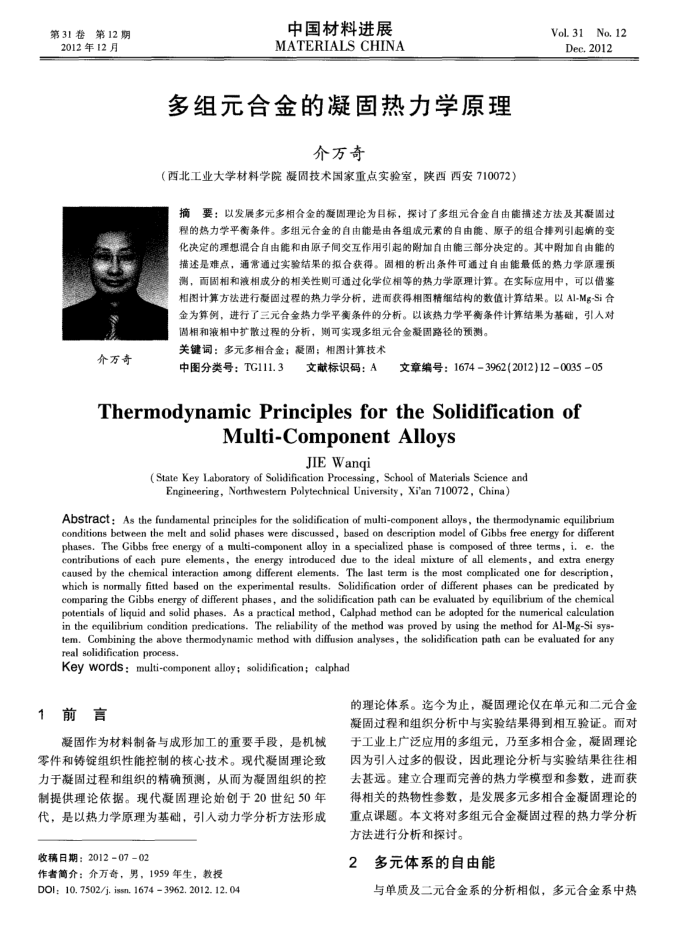您当前的位置:首页>论文资料>多组元合金的凝固热力学原理
内容简介
 第31卷第12期 2012年12月
第31卷第12期 2012年12月介万奇
中国材料进展 MATERIALSCHINA
组元合金的凝固热力学原理多
介万奇
(西北工业大学材料学院凝固技术国家重点实验室,陕西西安710072)
摘
Vol.31
No.12
Dee. 2012
要:以发展多元多相合金的凝固理论为目标,探讨了多组元合金自由能措述方法及其凝固过
程的热力学平衡条件。多组元合金的自由能是由各组成元索的自由能、原子的组合排列引起的变化决定的理想混合自由能和由原子间交互作用引起的附加自由能三部分决定的。其中附加自由能的描述是难点,通常通过实验结果的拟合获得。固相的析出条件可通过自由能最低的热力学原理预测,面固相和液相成分的相关性则可通过化学位相等的热力学原理计算。在实际应用中,可以借鉴相图计算方法进行凝固过程的热力学分析,进而获得相图精细结构的数值计算结果。以AI-Mg-Si合金为算例,进行了三元合金热力学平衡条件的分析。以该热力学平衡条件计算结果为基础,引人对
固相和液相中扩散过程的分析,则可实现多组元合金影固路径的预测。关键词:多元多相合金;凝固;相图计算技术
中图分类号:TG111.3
文献标识码:A
文章编号:16743962(2012)12003505
Thermodynamic Principles for the
eSolidificationof
Multi-Component Alloys
JIEWanqi
(State Key Laboratory of Solidification Processing, School of Materials Science and Engineering, Northwestern Polytechnical University, Xi'an 710072, China)
Abstract : As the fundamental principles for the solidification of multi-component alloys, the thermodynamic equilibrium conditions between the melt and solid phases were discussed, based on description model of Gibbs free energy for different phases. The Gibbs free energy of a multi-component alloy in a specialized phase is composed of three terms, i. e, the contributions of each pure elements, the energy introduced due to the ideal mixture of all elements, and extra energy caused by the chemical interaction among different elements. The last term is the most complicated one for description, which is normally fitted based on the experimental results, Solidification order of different phases can be predicated by comparing the Gibbs energy of different phases, and the solidification path can be evaluated by equilibrium of the chemical potentials of liquid and solid phases. As a practical method, Calphad method can be adopted for the numerical calculation in the equilibrium condition predications. The reliability of the method was proved by using the method for Al-Mg-Si sys-tem. Combining the above thermodynamic method with diffusion analyses, the solidification path can be evaluated for any real solidification process-
Key words: multi-component alloy; solidification; calphad
1前言
凝固作为材料制备与成形加工的重要手段,是机械零件和铸锭组织性能控制的核心技术。现代凝固理论致力于凝固过程和组织的精确预测,从而为凝固组织的控制提供理论依据。现代凝固理论始创于20世纪50年代,是以热力学原理为基础,引人动力学分析方法形成
收稿日期:2012=07-02
作者简介:介万奇,男,1959年生,教投
DOI: 10. 7502/j. issn. 1674 3962. 2012. 12. 04
的理论体系。迄今为止,凝固理论仅在单元和二元合金凝固过程和组织分析中与实验结果得到相互验证。而对于工业上广泛应用的多组元,乃至多相合金,凝固理论因为引入过多的假设,因此理论分析与实验结果往往相去甚远。建立合理而完善的热力学模型和参数,进而获得相关的热物性参数,是发展多元多相合金凝固理论的重点课题。本文将对多组元合金凝固过程的热力学分析方法进行分析和探讨。
2
多元体系的自由能
与单质及二元合金系的分析相似,多元合金系中热